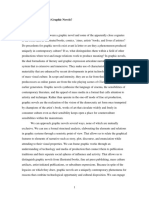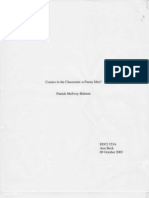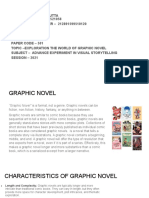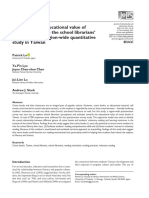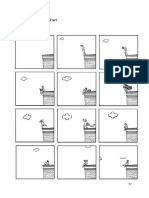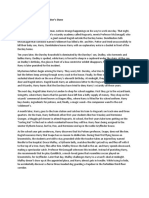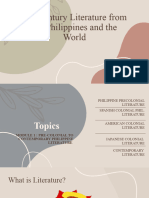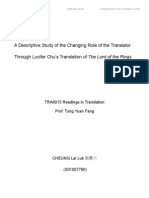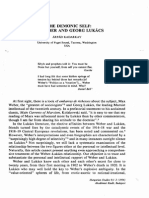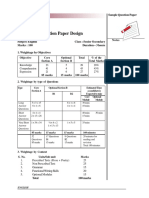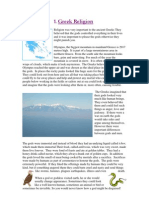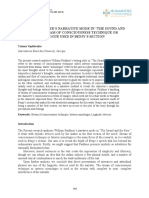Dallacqua ExploringLiteraryDevices 2012
Uploaded by
valentinapinedasuarezDallacqua ExploringLiteraryDevices 2012
Uploaded by
valentinapinedasuarezExploring Literary Devices in Graphic Novels
Author(s): Ashley K. Dallacqua
Source: Language Arts , July 2012, Vol. 89, No. 6, Insights and Inquiries (July 2012), pp.
365-378
Published by: National Council of Teachers of English
Stable URL: https://www.jstor.org/stable/41804360
JSTOR is a not-for-profit service that helps scholars, researchers, and students discover, use, and build upon a wide
range of content in a trusted digital archive. We use information technology and tools to increase productivity and
facilitate new forms of scholarship. For more information about JSTOR, please contact support@jstor.org.
Your use of the JSTOR archive indicates your acceptance of the Terms & Conditions of Use, available at
https://about.jstor.org/terms
National Council of Teachers of English is collaborating with JSTOR to digitize, preserve and
extend access to Language Arts
This content downloaded from
45.5.167.198 on Tue, 18 Feb 2025 04:16:06 UTC
All use subject to https://about.jstor.org/terms
Ashley K. Dallacqua
page
365
Exploring Literary Devices
in Graphic Novels
We can no longer treat literacy (or "language") as the
sole, the main, let alone the major means for represen-
as far as the Middle Ages (Sabin, 1996),
tation and communication. Other modes are there as
Although as it's far onlyit's onlyas thebeenbeen
withinthetheidea
last 20Middle within of comics the Ages last (Sabin, can 20 date years 1996), back that
years that
well, and in many environments where writing occurs,
comics and graphic novels have been more widely these other modes may be more prominent and more
suggested as legitimate literature (Connors, 2007; significant, (p. 35)
McTaggart, 2008; Versaci, 2008). Following what
Kress (2003) highlights the importance of mul-
is referred to as the "Golden Age" of the 1940s,
timodality, especially when it comes to visual lit-
comics were viewed negatively, especially after the
eracy. Similarly, Schwarz (2007) notes the value of
publication of Wertham's Seduction of the Inno-
graphic novels and their images when she quotes
cent in 1954 (Sabin, 1996; Krashen, 2004; Versaci,
Burmark, writing: "Welcome to the age of images.
2008). Wertham's study stated that comics were
The signs are everywhere - for those who can read
harmful to readers and led to delinquency.
them" (<I 2). The overall consensus on defining visual
While some negative perceptions still exist,
literacy focuses around the ability to create, read,
comics have come a long way since the 1940s
and/or understand visual messages (Burmark, 2002).
(Connors, 2007; Versaci, 2008). In 1978, Will Eis-
Providing students with several modes (including
ner wrote A Contract with God (2006), popular-
visual), in which to give and receive information,
izing the term graphic novel. In 1992, the graphic
offers them multiple ways to make sense of a story.
novel Maus (Spiegelman, 1991) won the Pulitzer
Because of the strong images in graphic novels, they
Prize. Since then, the medium has grown and devel-
lend themselves to teaching literary devices as well.
oped into its own entity (McTaggart, 2008). Carter
Along with promoting visual literacy, graphic
(2007) defines a graphic novel as a "book-length
novels call on many complex literacy skills to decode
sequential art narrative featuring an anthology-style
images and print text (Butcher & Manning, 2004).
collection of the comic art, a collection of reprinted
Carter (2007) asserts that graphic novels require
comic book issues comprising a single story line (or
both visual literacy and critical literacy, as readers
arc), or an original, stand-alone graphic narrative"
to take an active role in reading by questioning the
(p. 1). Essentially, graphic novels use images and
author's motives and analyzing particular viewpoints
print text to engage readers and tell a story. Readers
(Fisher & Frey, 2007; Versaci, 2008). He maintains
walk with characters and see from their points of
that graphic novels and comics should be seen as
view. Print text and images are equally important,
equal partners with other texts and media because
both providing essential information to the story.
they necessitate multiple reading strategies and lay-
Using graphic novels in classrooms promotes
ers of attention. "Comics give voice to parts of young
multimodality - the combination of two or more
readers' experience and imagination; they play a key
modes of communication - by using images and
role in cross-media theme development, and they
printed text to transfer information. Multimodality
illustrate multiple ways of presenting information -
is valued by many researchers in the field, including
verbal, visual, and graphic" (Heath & Bhagat, 2004,
Kress (2003), who writes:
Language Arts, Volume 89 Number 6, July 2012
This content downloaded from
45.5.167.198 on Tue, 18 Feb 2025 04:16:06 UTC
All use subject to https://about.jstor.org/terms
Ashley K. Dallacqua | Exploring Literary Devices in Graphic Novels
page
366
novels, The Arrival (2006) and American Born Chi-
p. 591). In short, comics provide complex literature
that mirrors a reader's world. nese (2006), in depth. During this study, the stu-
dents and I discussed the presence and use of liter-
Reading Graphic Novels ary devices in the graphic novels, and I realized that
with Fifth Graders many literary devices, like point of view and sym-
In 2010, I conducted a study with four fifth-grade bolism, are quite visual. Upon reflection, I realized
students to explore the ways they engaged withthat using these graphic novels to introduce diffi-
graphic novels. Together, we discussed two graphic cult literary devices could help scaffold students to
Comic Art is a form of storytelling that uses texts and images to express the mood and action of a story. The four main
categories are: cartoons, comic strips, comic books, and graphic novels.
Comic Books use a deliberate sequence of art and text to express a storyline.
Graphic Novels are considered to be comics that have lengthy and multifaceted storylines, like a chapter book. The
pictures in graphic novels are as integral to the story as the words themselves.
Manga are Japanese comics that are based on animated films and television shows. Manga includes a broad range of
subjects and the stories rely heavily on visual cues rather than text.
Why use comics and graphic novels in the classroom?
Motivate students to read-Children are powerfully attracted to comics and graphic novels; they willingly gravitate
toward these books.
Teach literary devices - Readers are required to be actively engaged in the process of decoding and comprehending a
range of literacy devices, including narrative structure, metaphor and symbolism, point of view, and the use of puns,
alliteration, and inferences.
Teach the classics- Classic novels that have been adapted to graphic novels provide a different way to read the work
without altering the characters, themes, and tones.
Promote Critical Literacy- Graphic novels and comics can help explain how language works both for and against
people; they enable students to acquire an appreciation for critical literacy.
Support struggling readers - Illustrations provide contextual clues to help students understand the meaning of the
written narrative. Visual imagery helps students understand difficult and abstract concepts.
For booklists and additional information on comics and graphic novels:
• http://www.ncte.org/magazine/archives/122031
• http://reviews.libraryjournal.com/category/books/graphic-novels/?ref=menu
• http://www.schoollibraryjournal.com/article/CA6312463.html
Sources
Miller, S. (2005). Developing and promoting graphic novels. New York, NY: Neal Schuman Publishers.
McCloud, S. (1993). Understanding comics: The invisible art. New York, NY: HarperCollins.
- Natasha A. Thornton
Graduate student in Middle-Secondary Education
and Instructional Technology Departments, Georgia State University
Language Arts, Volume 89 Number 6, July 2012
This content downloaded from
45.5.167.198 on Tue, 18 Feb 2025 04:16:06 UTC
All use subject to https://about.jstor.org/terms
Ashley K. Dallacqua | Exploring Literary Devices in Graphic Novels
page
367
recognize them in textual readings. By introducing like Maus I and Maus II (Spiegelman, 1986, 1991)
literary devices visually in graphic novels like Bone and Cartoon History of the Universe (Gonick,
(Smith, 2004), The Arrival (Tan, 2006), and Ameri- 1997) provide visual histories rich with detail and
can Born Chinese (Yang, 2006), I could transition description. Persepolis (Satrapi, 1969/2003), an
into print-based literary devices, such as those in autobiography of an Iranian girl, is required reading
Sign of the Beaver (Speare, 1983), Maniac Magee at West Point, as it discusses racial and historical
(Spinelli, 1990), and The Giver (Lowry, 1993). issues in Iran (Foroohar, 2005).
As our class read print-based novels, we Schwarz (2002) suggests comics and graphic
focused on literary devices like point of view, allu- novels for science and math classrooms as well,
sion, themes and morals, tone and mood, symbol- such as The Cartoon Guide to Statistics (Gonick
ism, and flashback and foreshadowing - concepts & Smith, 1993), which uses cartoon characters and
that were often difficult for me to teach and for sequential art to teach mathematical formulas and
my students to grasp. Prior visual knowledge from equations. Schwarz also notes the options of study-
graphic novels, however, strengthened my lessons ing the graphic novels as art forms themselves. Stu-
and advanced my students' understanding. I con- dents examine how images are portrayed by differ-
cluded that educators would profit from looking at ent graphic novelists, just as they might any other
comics as transitional, conduit material, a point of piece of art.
view shared by Krashen (2004) and Carter (2007).
Graphic Novels in the
But Carter also asserts that the opposite can be true.
Rather than being just a stepping stone, graphic Language Arts Classroom
novels can be sophisticated and challenging texts in Language arts classrooms are another space for
and of themselves, serving as tools to teach com- graphic novels. Teaching dialogue could be intro-
plicated concepts. When presenting comics and duced using a graphic novel, since it is neatly
graphic novels as valid options among student read- divided into speech bub-
ing choices, engagement in literacy will happen. bles (Schwarz, 2002). When presenting comics
Along with dialogue,
and graphic novels as valid
Graphic Novels and Comics teachers can take advan-
as Academic Resources tage of graphic novels' options among student reading
Current scholarship promotes comics and graphicstrong vocabulary (Heath
choices, engagement in
& Bhagat, 2004). Krash-
novels in libraries and academic settings, citing
en's (2004) research bol- literacy will happen .
their potential for engagement, as well as their aca-
demic benefits. Research shows graphic novels stersas this idea, noting that
by reading a comic book every day, young read-
successful tools for a "wide range of subjects and
ers take in about 500,000 words in a year. Krashen
benefitting] various student populations, from hesi-
notes that the complex vocabulary in comics has a
tant readers to gifted students" (Carter, 2007, p. 1).
My review of current research examines the use of "respectable level of difficulty" (2004, p. 99).
graphic novels and comics to teach content areas Graphic novels provide other elements valu-
able to language arts classrooms. In 2005, Graphix
(especially language arts), social and cultural issues,
and visual literacy. The specific skills requiredof
toScholastic created a guide for reading the graphic
novel Bone (Smith, 2004), listing numerous literary
read a graphic novel as well as their connection to
devices that can be taught, such as point of view,
the reader response theory is also discussed.
theme, and allusion. Graphic novels are also benefi-
Graphic Novels across Content Areas cial in exploring tone and mood, using the color and
visual cues from the images along with the printed
Graphic novels offer possibilities for teaching
text (Fisher & Frey, 2007). In Monnin's Teaching
across content areas. They can be useful as histori-
Graphic Novels (2010), a resource for teachers,
cal literature (Butcher & Manning, 2004). Books
Language Arts, Volume 89 Number 6, July 2012
This content downloaded from
45.5.167.198 on Tue, 18 Feb 2025 04:16:06 UTC
All use subject to https://about.jstor.org/terms
Ashley K. Dallacqua | Exploring Literary Devices in Graphic Novels
page
368
and Herobear and The Kid: The Inheritance (Kun-
she provides classroom reproducibles, examples,
kel, 2003) are two other titles aimed for young
and instructions for teaching literary elements like
readers that address divorce and death.
symbols, foreshadowing, themes, and setting. And
Bitz (2010), while helping students to write com-
ics through his Comic Book Project, takes timeGraphic
to Novels and Visual Literacy
discuss other literary elements of comics. Strong
Graphic novels not only attract readers to literature
vocabulary and literary elements are fundamentals
but also require them to use more complex read-
that educators look for when choosing high-quality
ing skills to interpret images (Schwarz, 2002). As a
reading material within every content area. Graphic
result, graphic novels can be tools to sharpen visual
novels with these elements engage readers and pro-
literacy skills. Jewitt, Kress, Ogborn, and Tsatsar-
vide opportunities for critical discussions. elis (2001) conducted an empirical study of the
benefits of using print text and image together in a
Using Graphic Novels to Teach science lab. They suggest that "visual realization of
Social and Cultural Issues
meaning is important. Learning can no longer use-
Discussions of social and cultural issues take fully
placebe considered a purely linguistic accomplish-
in any content area, in any classroom. Graphic
ment" (p. 17). By comparing written and illustrated
novels can be valuable in this context, too. Bitz's
portions of their lab sheet, they found that each
(2009) Comic Book Project, mentioned above,
mode gave different information about the lesson.
reflected students' own cultural and social fears The illustrations reflected students' knowledge of
cell structure, while the written work showed an
and hardships. In addition, many existing graphic
novels can be used when teaching social issues,
understanding of the lab format. What was pro-
vided in illustration could not have been provided
such as homelessness, violence, rape, or incest. The
Tale of One Bad Rat (Talbot, 1995), for example,
in writing and vice versa.
depicts these difficult themes (Bucher & Manning,Multimodality is critical in communication,
and images are significant not only in classroom
2004). In another instance, pairing The Scarlet Let-
ter (Hawthorne, 1850/2009) and an autobiographi-
settings but in any social format (Kress, 2003).
cal graphic novel, The "The increasing demand for a workforce and citi-
Multimodality is critical inAmazing "True" Story zenry that is comfortable with multiple literacies,
of a Teenage Single Mom as opposed to one factory model of literacy, is at
communication , and images
(Arnoldi, 1998), helped least one argument for why comics could have a
are significant not only inCarter (2007) create an place in an English language arts classroom" (Bitz,
academic space for seri- 2010, p. 39). As educators, it is our job not only to
classroom settings but in anyous discussions of teen
meet content standards, but also to prepare students
pregnancy in his class-
social format . . . Graphic to be citizens of the world. Graphic novels provide
room. Using cultural criti-
opportunities to strengthen visual literacy.
novels provide opportunities to
cism as the vantage point
Reader Response Theory
strengthen visual literacy.and Persepolis (Satrapi,
and
2003) as the novel, Con- Graphic Novels
nors (2007), a high school language arts teacher,
When reading images and print text, a reader is
created ways for students to deal with tension in some freedom of interpretation (Kress,
allowed
cultural differences and find strong connections
2004; McCloud, 1993). This idea can be labeled as a
in previously buried similarities. Using a graphic
transaction or a "two-way process involving a reader
novel like American Born Chinese (Yang, 2007)
and a text" (Rosenblatt, 1982, p. 268). Rosenblatt's
aids in exploring themes of race and stereotypes
theories of reader-response carry over into graphic
to support a younger audience. Lions , Tigers , andAn argument can also be made that indi-
novels.
Bears: Fear and Pride (Bullock & Lawrence,vidual
2006)experiences in reading, according to reader-
Language Arts, Volume 89 Number 6, July 2012
This content downloaded from
45.5.167.198 on Tue, 18 Feb 2025 04:16:06 UTC
All use subject to https://about.jstor.org/terms
Ashley K. Dallacqua | Exploring Literary Devices in Graphic Novels
page
369
response theory, can also influence educators' text and contributions to the story as it unfolds" (Hogan
selection (Monnin, 2010). In her resource Teaching & Bakis, 2011). Sipe and Brightman (2009) con-
Graphic Novels , Monnin also provides space for ducted a study using picturebooks, grounding their
"text potential," which is that "unique meaning cre- methods in reader-response theory. This resulted
ated between the reader and the text" (2007, p. 27). in the theory that allowing young readers to fill in
Other educators have followed Rosenblatt's the gaps at page breaks of picturebooks may enrich
meaning making and invite high-level inferencing
lead. Bakis, a teacher and avid supporter of graphic
skills. Another study using American Born Chi-
novels in the classroom, notes in an interview that
"In order to understand how to read comics, read-
nese (Yang, 2006) concluded that readers respond
to graphic novels, noting numerous literary devices
ers must also pay attention to their own reactions
One of the best ways for students to understand a genre is to experience it from the inside out - by creating the
genre themselves. Students can gain an architect's knowledge of the literary devices mentioned in the article, as well
as the graphic messages that dominate today's media (Kimber & Wyatt-Smith, 2006; Gee, 2003). In her book Study
Driven (2006), Katy Wood Ray recommends comic books and/or graphic novels as one of many exciting text forms that
students can experiment with.
Want to know how to get started?
First: Immerse the students in the genre. In addition to texts mentioned in this article, consider these funny bone-
tickling treasures featured on the School Library Journal blog: http://www.schoollibraryjournal.com/slj/home/891089-
312/comic_relief_thirty-nine_graphic_novels.html.csp.
Next: Allow students the opportunity to discuss the books, focusing not only on what the authors/illustrators are
trying to communicate, but on how the authors are communicating. Ray suggests that students create charts of the
commonalities of structure, tricks, and style across many examples within the genre.
Finally: Get started writing! Encourage students to create (as Ray puts it) "under the influence" of what they've
learned from studying the genre. Jarret Krosoczka, author of the Lunch Lady series, starts his projects with a story
map. More guidance (and fun) may be found in the book, Monkey Boy to Lunch Lady: The Sketchbooks of Jarret J.
Krosoczka (201 1).
References
Gee, J. P. (2003). What do video games have to teach us about learning and literacy? New York, NY: Palgrave/
Macmillan.
Kimber, K., & Wyatt-Smith, C. (2006). Using and creating knowledge with new technologies: A case for students-
as-designers. Learning , Media , and Technology, 37(1), 19-34.
Krosoczka, J. J. (201 1). Monkey boy to lunch lady: The sketchbooks of Jarret J. Krosoczka. Northampton, MA:
Studio JJK.
Ray, K. W. (2003). Exploring inquiry as a teaching stance in the writing workshop. Language Arts, 83, 238-247.
Ray, K. W. (2006). Study driven: A framework for planning units of study in the writing workshop. Portsmouth, NH:
Heinemann.
- Marva Solomon
Angelo State University
Language Arts, Volume 89 Number 6, July 2012
This content downloaded from
45.5.167.198 on Tue, 18 Feb 2025 04:16:06 UTC
All use subject to https://about.jstor.org/terms
Ashley K. Dallacqua | Exploring Literary Devices in Graphic Novels
page
370
in both print text and image portions of the graphic American. The 70 fifth graders in the school reflect
novel (Hammond, 2009). the school's overall demographics. My students
Sipe's (1998) earlier ideas on oscillating were ages 10 and 11, and the class was half female,
between print text and image while reading a pic- half male.
turebook can also be applied to graphic novels. In I read four graphic novels during the year. The
a graphic novel, both print text and images pro- first two, Amelia's School Survival Guide (Moss,
vide essential information to move a story forward; 2002) and Bone : Out from Boneville (Smith, 2004),
therefore, the oscillation process becomes more were part of my regular class curriculum and also
complex. McCloud supported this conclusion by became part one of my data collection and analy-
writing that as you are reading a graphic novel, sis (see Appendix A). They also served as an intro-
"what you see is seldom what you get if all you are duction to graphic novels to my participants. While
seeing is just ink and paper. In the end, what you these graphic novels were not part of the small-
get is what you give" (1993, pp. 136-137). A reader group discussions that came later in the study, they
must contribute to the story, participate, in order for provided important vocabulary and background
the story to take place. knowledge in reading the two graphic novels this
study revolved around: The Arrival (Tan, 2006) and
Study Background, Method, American Born Chinese (Yang, 2006; see Appen-
and Analysis dix A). I used the time teaching Bone and Amelia 's
I conducted my research during the 2009-2010 School Survival Guide to keep a teacher-journal in
school year, working with fifth graders from my preparation for conducting this study of graphic
school. The scholarship of McCloud (1993) and novels and engagement. This journal, combined
Sipe (1998), supported by previous research on with my lesson plans and materials, served as the
reader-response theory from Rosenblatt (1982), initial data for my study.
triggered my thinking
The Participants
I found that these literal gaps, about engagement while
reading a graphic novel. I chose four students from the 70 in the fifth-grade
or gutters, in graphic novels
I wondered what it might class. These students were avid readers and strong
provided ample opportunities look like to engage in a communicators. They also actively shared their read-
graphic novel with my ing materials with me. Based on these criteria, I felt
for readers to engage and students. Comics and the students would be comfortable and willing to dis-
contribute to storytelling . cuss their reading process in front of me, their peers,
graphic novels contain
and a camera. After receiving parental consent and
empty spaces between the
panel closures, called gutters (McCloud, the participants'
1993). I assent, I began the study.
Participants were Shannon, Jason, Laura, and
found that these literal gaps, or gutters, in graphic
Gina (pseudonyms).
novels provided ample opportunities for readers to Shannon is a European Ameri-
can female who is vocal in class and is comfortable
engage and contribute to storytelling. Sipe's sug-
gestion that readers participate in creatingchallenging
a story the ideas of teachers and peers. This
by filling in gaps is what ultimately informedwas
year my her first real exposure to graphic novels.
Jason
research question: In what ways do readers is the only boy who participated in the study
engage
while reading a graphic novel? and is European American. Jason loves to read and
regularly recommends books and series to me. He
Background to the Study also expressed great interest in graphic novels, even
Our school is a private, parochial school in though he has not had much experience with them.
the sub-
Laura,
urbs of a mid-sized Midwestern city. The a European American female, is a little qui-
school
eter insize
holds about 570 students, with an average class class but one who seems to be thinking all the
time. She is smart, with quiet confidence. Finally,
of 30. Students are primarily middle class European
Language Arts, Volume 89 Number 6, July 2012
This content downloaded from
45.5.167.198 on Tue, 18 Feb 2025 04:16:06 UTC
All use subject to https://about.jstor.org/terms
Ashley K. Dallacqua | Exploring Literary Devices in Graphic Novels
page
371
there is Gina, an African American who is not only of triangulation (Hubbard & Power, 2003), I used
an avid reader, but an avid graphic novel reader. my teacher journal, transcripts from two book dis-
Gina is known as the class artist, so the medium of cussions, and transcripts from student interviews
graphic novels speaks to her. to validate (or not) my reoccurring themes. As I
wrote multiple analytic memos of each experience,
Book Discussions and Interviews
I simultaneously indexed all that I was seeing and
experiencing with my students in order to narrow
During the spring quarter, I met with my partici-
pants as a group twice. Prior to our meetings, I my focus and identify common themes. After inter-
gave
views were complete, I began the most intense por-
each student a copy of The Arrival (Tan, 2006) and
American Born Chinese (Yang, 2006) and a packet tion of analysis: re- watching the video footage, tak-
ing notes, and highlighting themes throughout all
of sticky notes. I asked them to read through each
three sources of data.
book and suggested that if they had time, they reread
and use the sticky notes to identify the parts they All of the data collected supported, or at least
did not negate, my findings. One prominent theme
found particularly interesting, confusing, beautiful,
was the presence of literary devices within a graphic
or worth talking about for any reason. The partici-
pants had a week to read each book. novel. I did member checks, walking my students
through my findings and
My classroom provided an academic back-
taking notes on their com- Knowing that they were being
drop for our book discussions. Both discussions
ments, questions, sugges-
were videotaped, an appropriate visual collection used for a study encouraged these
method for a visual literature medium. As students tions, and corrections. All
students to work harder . . .
discussed a visual piece of a story, they would often four students validated
react with their bodies, so video allowed me to cap- these recurring themes. the
I readers continually brought
ture all forms of engagement, not just verbal ones. used my notes to polish
Each discussion lasted about an hour. up literary devices found as
and support my results
During our first meeting, we discussed the and, with validation fromthey read.
wordless graphic novel The Arrival; during our my participants, began
second meeting, we discussed American Born Chi-transcribing video footage that spoke to recurring
nese. I predetermined some discussion questionsthemes and deepening my analysis. After being
based on analysis of my class work, but I generally outlined, tested against the rest of my data, and
let the students guide conversations with their com- supported by member checks, one major theme
ments, questions, and marked sections. emerged - a focus on literary devices.
Following the discussions, I analyzed the vid-
eotape footage and my teacher journal. I then cre-Literary Devices in Graphic Novels
ated an outline of our discussion, determining As I mentioned, our discussions took place in our
which parts were pertinent to my research questionclassroom. The readers acknowledged that they
and noting potential themes. Based on this reflec-may have been reading graphic novels differently
tion and students' individual contributions to our
than how they thought a typical reader would.
group discussion, I developed several questions As Shannon put it, "They [readers] might just be
for each student. I conducted and videotaped one- slacking and not really care and not really think-
on-one interviews with all four participants, during ing much about it, like we did, because we kind
which I asked the series of prepared questions, as of had to, because it's our book club and we have
well as follow-up questions when necessary. to impress the camera." Knowing that they were
being used for a study encouraged these students
Data Analysis to work harder. Although it was made clear to them
By the end of data collection, I had three major that there would be no grades, the readers continu-
sources of data to analyze. Using Webb's method ally brought up literary devices found as they read.
Language Arts, Volume 89 Number 6, July 2012
This content downloaded from
45.5.167.198 on Tue, 18 Feb 2025 04:16:06 UTC
All use subject to https://about.jstor.org/terms
Ashley K. Dallacqua | Exploring Literary Devices in Graphic Novels
page
372
These students were used to discussing literary ele- noticed it on their own because of the striking
ments in this room with me, so the elements came images that grabbed their attention and clued them
up naturally in our conversations. It is important to in to the change.
note that although many readers compartmentalize While reading Bone (Smith, 2004), I also
graphic novels and comics into a pleasure reading taught the concept of allusion. During the reading
column, when placed in an academic setting, they of The Arrival students immediately clued in to the
became academic. fact that the entire story alluded to an immigrant's
trip to Ellis Island. Shannon explained, "Before I
This was true with the graphic novels we read
was a little confused, and it was a lot, um, vague.
as a whole class prior to the study. Amelia ' s School
But, um, this we learned about in social studies, so
Survival Guide (Moss, 2002) served as an introduc-
tion to the school year and to the format and partsit
ofwas really easy to recognize."
a graphic novel. During the reading of Bone (Smith, Jason chimed in, "Yeah, the Ellis Island!"
2004), I took time to focus on literary devices, "The Ellis Island!" Gina and Laura had made
the connection as well.
including point of view. The readers in my study
took information from my reading class and applied All four readers agreed that this story was about
it during our discussion within the study. Ellis Island. Shannon didn't just make a connection,
While discussing The Arrival (Tan, 2006), for
she recognized the place, showing how powerful
those images are to her.
instance, it was Gina who posed the question to the
group: "What point of view is this drawn in?" Shan- We discussed many other literary devices with
traditional literature during the school year as well,
non's answer was, "It can either be third person lim-
ited or third person omniscient, because even when
namely, symbolism, mood, flashback, foreshadow-
you do see him [the main character], you don't seeing, and jargon. In reading The Arrival, for example,
the ever-present dragon tail was discussed as a sym-
through his eyes, you see him." Thus, these students
bol. Shannon noted, "Um, I think it is saying . . .
showed an understanding of point of view and what
it might look like in a graphic novel. They also
it might be a war ... or it could just be a symbol
of sadness and, like, the economy going bad." The
acknowledged changes in point of view as different
characters told their stories within The Arrival , not-
page being discussed was also marked with a sticky
note, asking, "Does it symbol[ize] sadness?" (see
ing changes in color and facial close-ups as clues:
Fig. 1).
Shannon: It was hers [the story's point of
view] because you see the picture, and she's
telling him the story.
Ashley: How do you know she's telling him
the story? 'Cause he's [the main character]
been telling us the story all along, right?
Shannon: Uh, you see her take out the picture
and talk to him. And you see closer up.
Jason: Yeah, the picture's right there, then it
zooms, then it zooms again. And then it starts.
Gina: And it's like, a different color, the
background.
Laura: It stood out to me, because of the
color.
The Arrival's use of framing and color helped par-
Figure 1. Shannon works to understand symbolism in
Tan's (2006) The Arrival.
ticipants pinpoint a change in point of view. They
Language Arts, Volume 89 Number 6, July 2012
This content downloaded from
45.5.167.198 on Tue, 18 Feb 2025 04:16:06 UTC
All use subject to https://about.jstor.org/terms
Ashley K. Dallacqua | Exploring Literary Devices in Graphic Novels
page
373
Symbolism continued to be a part of our dis- what's gonna happen next, they just skip over it.
cussion as we worked with American Born Chinese Like, when I said he gave her origami, I didn't say
(Yang, 2006). First we talked about the stereotypi-
she kept looking at it and looking at it. I just said he
cal Chinese character, Chin-kee, and what he sym- gave her the origami, because the origami comes in
bolized. You could see wheels turning in readers'later." Again, the repeated images in the story drew
Shannon's attention. First, the origami was intro-
heads as they realized the symbolism. Jason said,
duced, then the origami bird image was repeated as
"It could be two parts of himself, the American half
and the Chinese half." We identified what all of the the main character sends them home to his daughter
characters symbolized in the large picture, which and eventually makes them for her when she arrives
led to the moral: be yourself, or as Gina put it in to live with him.
her interview, "You can't take . . . away yourself, My final example involves Gina's direct (and
because you are yourself!" unprompted) connection between the teaching of
Mood was also a very present part of our dis- literary devices in graphic novels and in print-based
cussion, especially as we read The Arrival. One novels. Gina pointed out the use of slang and jargon
student asked what the changes in color around the in American Born Chinese (Yang, 2006) and con-
border meant. Jason answered, "Like Shannon said, nected it to work by Jerry Spinelli and Lois Lowry.
a little bit of it is like the mood, like the part of the During the school year, the fifth grade had read
story." The color changes marked changes in mood, Spinelli's Maniac Magee (1990) and completed a
giving the readers visual clues as they read the mini-lesson on jargon and how and why Spinelli
story. In the beginning of the story, the pictures are used it. We had also recently finished a lesson with
shaded darkly because the main character is pack- The Giver (Lowry, 1993) about the specific lan-
ing to leave. Laura points out that the colors show guage the characters use. Gina said,
us, "they're [the character's family] sad that he's This is kind of referenced with Jerry Spinelli. Uh, a lot
leaving." Later in this story, once the main character of stuff they say . . . how would you call it, like some
arrives to a new, safer place, the colors brighten. slang words? ... A lot of graphic novels . . . it's kind of
like what people actually would say. The Giver is kind
Flashbacks and foreshadowing are also present
of more, uh, sophisticated, the grammar, the language.
in The Arrival. During our discussions, Laura first
But ... the Maniac Magee, um, Jerry Spinelli, they
pointed it out to us: made it, uh, he made it like actual people talking.
Laura: This picture, he flashes back to it, in She believed that Spinelli and Yang wrote the
... I don't know where.
way that people actually spoke: "It's actual people
Ashley: So what is it, specifically, that he
flashes back to?
Laura: The hands.
Laura had previously marked this image to share
with the group as well (see Fig. 2). Seeing the same
image repeated in the story struck her, calling her
attention to it. The visual flashback made sense to
her as a repeated image, and made the concept easy
to understand.
During Shannon's interview, we discussed the
foreshadowing images in The Arrival. After Shan-
non "read" some of the wordless story out loud, I
asked her why she had left out some details. She
said, "If you've read a book, like the foreshadow-Figure 2. An image helps to clarify Laura's understanding
of "flashback."
ing .. . they don't tell you every single hint about
Language Arts, Volume 89 Number 6, July 2012
This content downloaded from
45.5.167.198 on Tue, 18 Feb 2025 04:16:06 UTC
All use subject to https://about.jstor.org/terms
Ashley K. Dallacqua | Exploring Literary Devices in Graphic Novels
page
374
talking, so there's, there is some, um, slang." The novels: The Sign of the Beaver (Speare, 1983),
Giver's language was much more academic, which Maniac Magee (Spinelli, 1990), and The Giver
was fitting for the purpose. Gina was able to not (Lowry, 1993). Established through our discussions
only pick out a literary element, but also compare of Bone , the concept became a continuous conver-
and contrast it to the same element in two other sation throughout the rest of the year.
print-based novels. We have also looked at literary allusions within
Regardless of how the devices were presented,images, such as Bone's constant references to Moby
visually or in print, they were noticeable to the
Dick (Melville, 1851/201 1) and similarities to older
comics, such as Uncle Scrooge (Filipi & Smith,
readers in graphic novels. It has been noted that
2008). Shakespeare's Hamlet (1599-1601/2003)
the readers in this study put more effort into their
is even quoted, when one character, Phoney Bone,
reading than what is typical, bringing these literary
devices to light in our discussions. Even so, graphic
attempts to rig a race, saying, "It does sour my plans
novels such as those used for this project are rich
of amassing a huge fortune and retuning to Bon-
with elements of literature and can be used to teach eville in triumph .... Still, the play is th' thing!"
these elements as well. (Smith, 2004, p. 139). As a class, we discuss the
presence of other stories and ideas within this story.
Graphic Novels Support Print- Allusions come up yet again later in the year while
Based Text Understandings reading Jerry Spinelli's Maniac Magee (1990). At
When Gina made the connection between print- this point in the year, my fifth graders are already
based and graphic novels during our interview,familiar
I with the concept of allusions from Bone
and slide easily into this lesson.
felt like I had struck gold. I began to think about
other opportunities where I could partner graphic Our final novel for the year is Lois Lowry's The
Giver (1993). This novel is full of symbolism, fore-
novels with our texts to increase engagement and
shadowing, and flashbacks. In The Arrival, these
introduce literary elements. As Bitz (2010) writes,
"There are many connections to be made between concepts are visual, as referenced above. In print,
comics (e.g., Maus) and the accepted cannon however,
of they are abstract and can be difficult for
students to identify, so in 2011, I introduced The
literature (e.g., Diary of Anne Frank)" (p. 39). In
my own classroom, I already used the graphic novelArrival into my curriculum in the weeks before
starting The Giver. We began with a mini-lesson to
Bone to teach literary devices, such as point of view
and allusions. In the year following this study,define
I symbolism, foreshadowing, and flashback.
Then,
integrated The Arrival into my whole-class curricu- in groups, students took visual notes of the
storyline and of examples of symbols, foreshadow-
lum in order to introduce plot sequence, flashbacks,
foreshadowing, symbolism, tone, and mood. These and flashbacks, eventually sharing them with
ing,
the whole class.
lessons also scaffold students' analyses of print-
based novels. In this section, I will share what I With some visual background knowledge from
a book like The Arrival , students were better able
have taken from this study to inform my own class-
room curriculum. to visualize the flashbacks Jonas has in The Giver.
When teaching Bone: Out from Boneville The novel opens with a flashback, so in the middle
(Smith, 2004), I presented mini-lessons on point of of the second page, I stopped reading and asked,
view. We discussed the point of view as third per- "What's going on here?" Immediately hands shot
son omniscient as we followed multiple characters up, and not being able to contain themselves, sev-
throughout the story. This lesson served as an intro-
eral students shouted out, "It's a flashback!" This
duction to point of view that the students carried was a vast improvement over past classes' frustra-
with them the rest of the year. They were able to tion with the confusing beginning of this novel.
recognize the same point of view in our print-based This year, they began with confidence. Foreshad-
Language Arts, Volume 89 Number 6, July 2012
This content downloaded from
45.5.167.198 on Tue, 18 Feb 2025 04:16:06 UTC
All use subject to https://about.jstor.org/terms
Ashley K. Dallacqua | Exploring Literary Devices in Graphic Novels
page
375
owing and symbolism are other important elements of Chin-Kee, the Chinese cousin, helped us to see
within The Giver. All of these concepts came alive some of the negative reactions race can bring about.
for my students by recalling concepts and images This theme is also present in The Sign of the Beaver
from The Arrival. (Speare, 1983). I would love for students to be able
After working with my small group of par- to connect the images from American Born Chinese
ticipants reading The Arrival and American Born that show more current racism with ones set in the
Chinese and working with my whole class reading 1800s.
Bone and The Arrival , I began to see the poten- Maniac Magee offers yet another way to use
tial for many more lessons to scaffold into literary The Arrival in discussing mood with fifth graders.
devices that I teach to my class. Theme was a lit- We spent a lot of time discussing Spinelli's chang-
erary device that was ever-present in our graphic ing mood and tone as the book switches between
novel discussions. In small groups, my students parts one, two, and three. By recalling the use of
brought up the coloring of the skin in American color and shading in The Arrival's mood, we were
Born Chinese , as yellowed skin is a negative ste- able to compare those visual changes to the lan-
reotype of Chinese people. We discussed the theme guage changes, as the mood swiftly shifts from
of race in this novel and all of the visual cues bring- light and funny to dark and sad at the beginning of
ing race to the forefront of this story. The visuals Part Three in Maniac Magee.
ReadWriteThink.org has lesson plans and teaching resources on many of the texts mentioned in this article:
In the Text Messages podcast episode "Teen Identity and Tough Situations," the host discusses the graphic novel
American Born Chinese as well as five other recommended titles by a diverse array of authors. In American Born
Chinese , adolescent readers will love the bright, colorful panels and the humorous story of Jin, the son of Chinese
immigrants, who struggles to understand how to fit in at his American school without rejecting his Chinese heritage.
Podcast listeners also hear tips to share with adolescent readers before, during, and after reading this fantastic
graphic novel.
http://www.readwritethink.org/parent-afterschool-resources/podcast-episodes/teen-identity-tough-situations-30341
.html
Using The Giver in this ReadWriteThink.org lesson plan, students discuss the importance of recorded history. This
provides context for descriptive writing of students' own history in a lesson that integrates personal writing, research,
and literary response.
http://www.readwritethink.org/classroom-resources/lesson-plans/memories-matter-giver-descriptive-13.html
To prepare students for reading the graphic novel PersepoHs, this lesson uses a WebQuest to focus students' research
on finding reliable information about Iran before and during the Islamic Revolution.
http://www.readwritethink.org/classroom-resources/lesson-plans/gaining-background-graphic-novel-1063.html
Resources and research from James Bucky Carter was cited in the article. See his work on ReadWriteThink.org here:
http://www.readwritethink.org/about/bio/james-bucky-carter-201.html.
- Lisa Fink
www.readwritethink.org
Language Arts, Volume 89 Number 6, July 2012
This content downloaded from
45.5.167.198 on Tue, 18 Feb 2025 04:16:06 UTC
All use subject to https://about.jstor.org/terms
Ashley K. Dallacqua | Exploring Literary Devices in Graphic Novels
page
376
Conclusion References
Arnoldi, K. (1998). The amazing " true " story of a teenage
While graphic novels can scaffold readers' transi-
single mom. New York, NY: Hyperion.
tions into different modes of literature or literary
Bitz, M. (2009). Manga high. Cambridge, MA: Harvard
elements, I am not advocating for handing a graphic Education Press.
novel to a struggling or reluctant reader in the hope
Bitz, M. (2010). When commas meet kryptonite. New York,
that they will segue easily to traditional, print text NY: Teachers College Press.
later. That fact does not lessen graphic novels' value
Bûcher, K. T., & Manning, M. L. (2004). Bringing graphic
or academic weight. Graphic novels, like the ones novels into a school's curriculum. The Clearing
used in this study, stand equally with print-based House , 28, 67-72. Retrieved June 19, 2007, from
literature as complex, academically challenging, Academic Search Complete database, doi: 10.3200/
TCHS.78.2.67-72
and rich with literary elements and devices.
Bullock, M., & Lawrence, J. (2006). Lions , tigers, and
The fact that the participants in this study made
bears: Fear and prides. Berkeley, CA: Image Comics.
so many academic connections was no accident. I
Burmark, L. (2002). Visual literacy: Learn to see, see to
established an academic setting surrounded by the
learn. Alexandra, VA: Association for Supervision and
books they had read for the study and for my read- Curriculum Development.
ing class. In fact, the readers informed me that they
Carter, J. B. (Ed.). (2007). Building literacy connections
believed they worked harder than the average reader with graphic novels. Urbana, IL: National Council of
while reading these books in hopes of impressing Teachers of English.
Connors, S. (2007). Graphic young adult novels:
both me and the camera. The academic setting also
made for academic discussions. Jason, one of the Deconstructing and reinterpreting Persepolis from a
cultural critical perspective. In A. Soter & M. Faust
participants, explained it this way:
(Eds.), Interpretive play: Using critical perspectives to
If this is your first graphic novel, you really won't teach young adult literature (pp. 179-190). Norwood
understand it . . . because if you don't know that a MA: Christopher-Gordon.
graphic novel is pictures and panels, um, showing you
Eisner, W. (1978/2006). A contract with God. New York,
the story, while telling you the plot at the same time. NY: W. W. Norton.
If you haven't read a graphic novel before, you won't,
Filipi, D., & Smith, J. (2008). Jeff Smith: Bone and beyond.
you won't understand it as much as everyone else, be-
Columbus, OH: Wexner Center for the Arts.
cause some of the pictures show action, and like, um, it
Fisher, D., & Frey, N. (2007). Altering English: Re-
shows emotions . . . they wouldn't know to look at the
facial expression or what they are doing or what he's examining the whole class novel and making room
surprised about or what he's thinking .... for graphic novels and more. In J. B. Carter (Ed.),
Building literacy connection with graphic novels
Jason's insightful observations show how com- (pp. 26-37). Urbana IL: National Council of Teachers
plicated and challenging he believes a graphic novel of English.
can be. But at the same time, he knows the "rules"
Foroohar, R. (2005, August 22). Comic relief. Newsweek.
to reading one, so he understands the story. While Retrieved July 3, 2009, from www.newsweek.com.
Gonick, L. (1997). A cartoon history of the universe, vols
there is much to interpret, there are also concrete
and academic elements to graphic novels. Even this 1-7. New York, NY: Broadway Books/Random House.
Gonick, L., & Smith, W. (1993). A cartoon history of
small study shows that the graphic novel is a power-
statistics. New York, NY: HarperCollins.
ful medium. Literary devices are not only present,
Graphix of Scholastic. (2005). Using graphic novels in
but recognizable to the students of this study with
the classroom: A guide for teachers and librarians.
no prompting from me. Imagine the graphic novel's
Retrieved July 13, 2008, from http://www.scholastic.
capabilities with a teacher's guidance! This medium com/graphix/Scholastic_BoneDiscussion.pdf.
will grab your students' attention, help them grasp Hammond, H. K. (2009). Graphic novels and multimodal
difficult literary concepts, and visualize those con- literacy : A reader response study (Unpublished doctoral
cepts as they scaffold into other modes of reading. dissertation, The University of Minnesota, Twin Cities).
Retrieved from http://convervancy.umn.edu.
Language Arts, Volume 89 Number 6, July 2012
This content downloaded from
45.5.167.198 on Tue, 18 Feb 2025 04:16:06 UTC
All use subject to https://about.jstor.org/terms
Ashley K. Dallacqua | Exploring Literary Devices in Graphic Novels
page
377
Hawthorne, N. (1850/2009). The scarlet letter, Nashville, Rosenblatt, L. M. (1982). The literary transaction:
TN: American Renaissance Books. Evocation and response. Theory into Practice , 21,
268-277.
Heath, S. B., & Bhagat, V. (2004). Reading comics, the
invisible art. In J. Flood, D. Lapp, S. B. Heath (Eds.), Sabin, R. (1996). Comics , comix, & graphic novels.
Handbook of research teaching literacy through London: Phaidon Press Limited.
communicative and visual arts (pp. 586-591). Satrapi, M. (1969/2003). Persepolis : The story of a
London: Routledge. childhood. New York, NY: Pantheon.
Hogan, J. (Interviewer), & Bakis, M. (Interviewee). (2011).
Schwarz, G. E. (2002). Graphic novels for multiple
Comics in the classroom: Expert advice from teachers literacies. Journal of Adolescent & Adult Literacy, 46,
[Interview Transcript]. Retrieved from Graphic Novel 262.
Reporter Website, http://www.graphicnovelreporter Schwarz, G. (2007). Media literacy, graphic novels, and
.com.
social issues. Simile, 7(4), 1-1 1, Retrieved June 30,
Hubbard, R. S., & Power, B. M. (2003). The art of
2009, from Academic Search Complete database.
classroom inquiry: A handbook for teacher- doi:10.3138/sim.7.4.002
researchers. Portsmouth, NH: Heinemann.
Shakespeare, W. (2003). Hamlet. New York, NY: Simon &
Jewitt, C., Kress, G., Ogborn, J., & Tsatsarelis, C.
Schuster. (Original work published 1601)
(2001). Exploring learning through visual,Sipe,
actional,
L. R. (1998). How picture books work: A semiotically
and linguistic communication: The multimodal framed theory of text-picture relationship. Children 's
environment of a science classroom. Educational
Literature in Education, 29, 97-107.
Review ; 53, 5-18.
Sipe, L. R. & Brightman, A. E. (2009). Young children's
Krashen, S. D. (2004). The power of reading: Insights interpretations of page breaks in contemporary picture
from the research (2nd ed.). Westport, CT: Libraries storybooks. Journal of Literacy Research , 41, 68-103
Unlimited.
Smith, J. (2004). Bone. Columbus, OH: Cartoon Books.
Kress. G. (2003). Literacy in the new media age. London:
Speare, E. G. (1983). The sign of the beaver. Boston, MA:
Routledge.
Houghton Mifflin.
Kress. G. (2004). Reading images: Multimodality,
Spiegelman, A. (1986). Maus I: A survivor's tale: My
representation, and new media. Information Design
father bleeds history. New York, NY: Pantheon.
Journal + Document Design , 72(2), 1 10-1 19.
Spiegelman, A. (1991). Maus II: A survivor's tale: And
Kunkel, M. (2003). Herobear and the kid : The inheritance.
here my troubles began. New York, NY: Pantheon.
Toluca Lake, CA: Astonish Factory.
Spinelli, J. (1990). Maniac Magee. Bellingham, WA: Little,
Lowry, Lois. (1993). The giver. New York, NY: Bantam Brown.
Books.
Talbot, B. (2010). The tale of one bad rat. Milwaukie, OR:
McCloud, S. (1993). Understanding comics: The invisible Dark Horse Books.
art. New York, NY: HarperPerennial.
Tan, S. (2006). The arrival. Melbourne, AUS: Levine
McTaggart, J. (2008). Graphic novels: The good, the bad, Books.
and the ugly. In N. Frey & D. Fisher (Eds.), Teaching
Versaci, R. (2008). Literary literacy and the role of the
visual literacy (pp. 21-A6). Thousand Oaks, CA:
Corwin Press.
comic book. In N. Frey & D. Fisher (Eds.), Teaching
visual literacy (pp. 91-1 11). Thousand Oaks, CA:
Melville, H. (1851/201 1). Moby Dick. New York, NY:
Corwin Press.
Simon and Brown.
Wertham. F. (1954). Seduction of the innocent. New York,
Monnin, K. (2010). Teaching graphic novels: Practical NY: Rinehart.
strategies for the secondary ELA classroom.
Yang, G. L. (2006). American born Chinese. New York,
Gainesville, FL: Maupin House.
NY: First Second.
Moss, M. (2002). Amelia's school survival guide. New
York, NY: Simon & Schuster Books for Young
Readers.
Ashley K. Dallacqua is a former fifth-grade teacher in Worthington, Ohio.
She can be reached at dallacqua. 1 @osu.edu.
Language Arts, Volume 89 Number 6, July 2012
This content downloaded from
45.5.167.198 on Tue, 18 Feb 2025 04:16:06 UTC
All use subject to https://about.jstor.org/terms
Ashley K. Dallacqua | Exploring Literary Devices in Graphic Novels
page
378
M
Tan, S. (2006). The Arrival Melbourne, AUS:
Levine Books.
N
Y
Tan's wordless story takes readers through a journey
Ameila 's School Survival Guide walks students of one man to a foreign and fictional land. He leaves
through preparing for the start of the school year. his wife and daughter behind to travel to a new place
Moss talks about how to deal with all types of to find shelter, food, and work. On his journey, he
teachers, sets up quizzes that will tell students meets several people who share their stories and help
what kind of student they are, and gives advice for him along his way. Eventually, our main character
studying in all subject areas. The pages look like is joined with his family in this new world. Tan's
notebook paper filled with notes, thoughts, and funnywhimsical and, at times, eerie illustrations connect
comments. There are details and comments in everyemotionally with the reader. This is a beautifully
corner. This graphic novel uses primarily text, with drawn story of a world full of new and confusing
visual images as embellishments. everyday objects that helps readers of any age
connect with ideas about immigration, new worlds,
Smith, J. (2004). Bone . Columbus, OH:
Cartoon Books. and the struggles that come with them.
Bone follows three cousins from their initial Yang, G. L. (2006). American Born Chinese.
banishment from Boneville through an epic adventure New York, NY: First Second.
in a faraway land. The cousins face danger, dragons, American Born Chinese is a set of three stories that
and the Lord of Locusts, who is hunting for them. cross over one another. It includes the old Chinese
Along the way, the Bone brothers befriend Thorn, Fable of the Monkey King who no longer wants to
Grandma Ben, Dragon, and the creatures of the be a monkey; the story of young Jin Wang, a Chinese
forest. They all work together to defeat the Lord American; and Chin-Kee, a negative caricature of a
of the Locusts and his rat creatures, and Thorn Chinese teenager. All of these characters suffer from
eventually takes her true place as queen. Bone: Out stereotyping and struggle with being comfortable
from Boneville is the first of nine books that make with their identities. Near the end of the book, the
up Jeff Smith's 1300-page graphic novel. Its vivid stories overlap and merge together, forcing all of
imagery and strong allusions tell a fictional and the characters to face themselves, their culture, their
fanciful tale to which any reader could connect. identities.
Language Arts, Volume 89 Number 6 , July 2012
This content downloaded from
45.5.167.198 on Tue, 18 Feb 2025 04:16:06 UTC
All use subject to https://about.jstor.org/terms
You might also like
- Exploring Literary Devices in Graphic Novels100% (2)Exploring Literary Devices in Graphic Novels14 pages
- Perceptions and Use of Graphic Novels in The Classroom PDF100% (1)Perceptions and Use of Graphic Novels in The Classroom PDF50 pages
- Literature Review The Effects of Comics As A Learning ToolNo ratings yetLiterature Review The Effects of Comics As A Learning Tool20 pages
- Graphic Novel: Literature Component For Form 1No ratings yetGraphic Novel: Literature Component For Form 170 pages
- Comics SelectedReferences 15november2016No ratings yetComics SelectedReferences 15november20165 pages
- Comics, Multimodality, and Multiliteracy: How Graphic Novels Fit Into The Changing Literary WorldNo ratings yetComics, Multimodality, and Multiliteracy: How Graphic Novels Fit Into The Changing Literary World7 pages
- Introduction Body Graphic Novels 1 Conclusion 1No ratings yetIntroduction Body Graphic Novels 1 Conclusion 18 pages
- Artículo - Rachel Marie-Crane Williams - Image, Text, and Story Comics and Graphic Novels in The ClassroomNo ratings yetArtículo - Rachel Marie-Crane Williams - Image, Text, and Story Comics and Graphic Novels in The Classroom8 pages
- Adventures in Genre! - Rethinking Genre Through Comics and Graphic Novels PDFNo ratings yetAdventures in Genre! - Rethinking Genre Through Comics and Graphic Novels PDF16 pages
- Baby-Sitters Little Sister. 1, Karen's Witch - Teacher Guide - 3112160% (5)Baby-Sitters Little Sister. 1, Karen's Witch - Teacher Guide - 311214 pages
- Revisiting The Multimodal Nature of ChilNo ratings yetRevisiting The Multimodal Nature of Chil11 pages
- Graphic Novels: Page by Page, Panel by PanelNo ratings yetGraphic Novels: Page by Page, Panel by Panel29 pages
- Will Eisner Theory of Comics Sequential ArtNo ratings yetWill Eisner Theory of Comics Sequential Art166 pages
- Reading Graphically - Comics and Graphic Novels For Readers From KNo ratings yetReading Graphically - Comics and Graphic Novels For Readers From K14 pages
- The Graphic Novel A Promising Medium For Learning ResearchNo ratings yetThe Graphic Novel A Promising Medium For Learning Research13 pages
- Amulet. Book One, The Stonekeeper - Guide To Using Graphic Novels - 37164100% (1)Amulet. Book One, The Stonekeeper - Guide To Using Graphic Novels - 3716416 pages
- Into The Puzzling Land. Pynchon, Hayles and Townsend Lost in The Field of ComplexityNo ratings yetInto The Puzzling Land. Pynchon, Hayles and Townsend Lost in The Field of Complexity167 pages
- Comics in The Classroom - A Funny Idea? (Oct. 2003 Scanned)100% (1)Comics in The Classroom - A Funny Idea? (Oct. 2003 Scanned)8 pages
- Artículo - Dale Jacobs - More Than Words Comics As A Means of Teaching Multiple LiteraciesNo ratings yetArtículo - Dale Jacobs - More Than Words Comics As A Means of Teaching Multiple Literacies8 pages
- Comic Books and Graphic Novels: The Undiscovered Medium100% (3)Comic Books and Graphic Novels: The Undiscovered Medium27 pages
- Usually Text and Image Support Each Other in Creating A Coherent MeaningNo ratings yetUsually Text and Image Support Each Other in Creating A Coherent Meaning6 pages
- Translating Comics and Graphic Novels: January 2018No ratings yetTranslating Comics and Graphic Novels: January 201823 pages
- Comic Strips A. Definitions of Comics and Comic StripsNo ratings yetComic Strips A. Definitions of Comics and Comic Strips4 pages
- Graphic Novels - Agents of Reading EngagementNo ratings yetGraphic Novels - Agents of Reading Engagement79 pages
- Lo Et Al 2021 Measuring The Educational Value of Comic Books From The School Librarians Perspective A Region WideNo ratings yetLo Et Al 2021 Measuring The Educational Value of Comic Books From The School Librarians Perspective A Region Wide18 pages
- Translating Comics and Graphic Novels: January 2018No ratings yetTranslating Comics and Graphic Novels: January 201823 pages
- Translating Comics and Graphic Novels: January 2018No ratings yetTranslating Comics and Graphic Novels: January 201823 pages
- MARTINS, Yan. of Graphic Novels - Approximations and Distances Beteween Comics and Literature (2022) - CompressedNo ratings yetMARTINS, Yan. of Graphic Novels - Approximations and Distances Beteween Comics and Literature (2022) - Compressed27 pages
- Barua Gaya and Buddha-Gaya Early HistoryNo ratings yetBarua Gaya and Buddha-Gaya Early History287 pages
- Isc Semester 1 Examination Specimen Question Paper English Paper 2No ratings yetIsc Semester 1 Examination Specimen Question Paper English Paper 22 pages
- Old Testament I Syllabus: Genesis-EstherNo ratings yetOld Testament I Syllabus: Genesis-Esther11 pages
- Wmvol 01-18 Keloglan and The Giant in The OrchardNo ratings yetWmvol 01-18 Keloglan and The Giant in The Orchard2 pages
- You Are About To Start A Secure Transfer With Send&Save, DirectlyNo ratings yetYou Are About To Start A Secure Transfer With Send&Save, Directly5 pages
- At The End of The Semester The Students Are Expected To: e Life and Works of Jose Rizal Econd Emester A.Y. 2012-201333% (3)At The End of The Semester The Students Are Expected To: e Life and Works of Jose Rizal Econd Emester A.Y. 2012-20133 pages
- The Demonic Self: Max Weber and Georg Lukács Árpád KadarkayNo ratings yetThe Demonic Self: Max Weber and Georg Lukács Árpád Kadarkay26 pages
- Historical Dictionary of Fantasy Literature, Second Edition (Z-Library)No ratings yetHistorical Dictionary of Fantasy Literature, Second Edition (Z-Library)579 pages
- Faulkner's Stream of Consciousness in "The Sound and the Fury"No ratings yetFaulkner's Stream of Consciousness in "The Sound and the Fury"10 pages
- Anatomy of The Fourth Gospel: A Study in Literary DesignNo ratings yetAnatomy of The Fourth Gospel: A Study in Literary Design5 pages

























